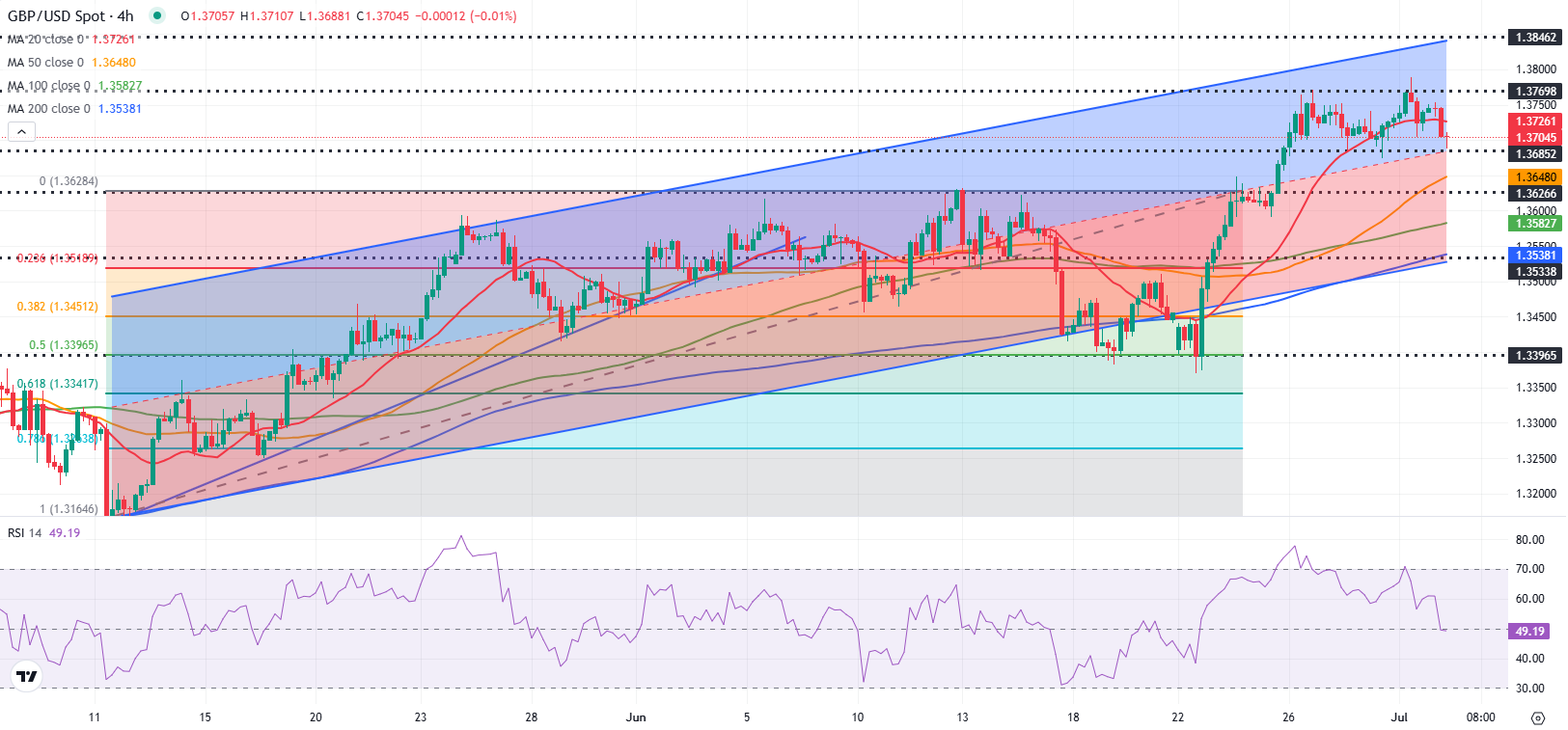
- GBP/USD trades in negative territory near 1.3700 on Wednesday.
- The technical outlook suggests that the downward correction could extend in the near term.
- Markets await private sector employment data from the US.
GBP/USD stays under bearish pressure on Wednesday and trades near 1.3700 after touching its highest level since October 2021 at 1.3788 on Tuesday. Investors await private sector employment data from the US.
British Pound PRICE Today
The table below shows the percentage change of British Pound (GBP) against listed major currencies today. British Pound was the weakest against the Canadian Dollar.
| USD | EUR | GBP | JPY | CAD | AUD | NZD | CHF | |
|---|---|---|---|---|---|---|---|---|
| USD | 0.28% | 0.31% | 0.35% | 0.00% | 0.16% | 0.29% | 0.17% | |
| EUR | -0.28% | -0.00% | 0.05% | -0.32% | -0.10% | 0.12% | -0.10% | |
| GBP | -0.31% | 0.00% | 0.04% | -0.33% | -0.15% | 0.09% | -0.13% | |
| JPY | -0.35% | -0.05% | -0.04% | -0.34% | -0.19% | -0.01% | -0.17% | |
| CAD | -0.00% | 0.32% | 0.33% | 0.34% | 0.17% | 0.39% | 0.18% | |
| AUD | -0.16% | 0.10% | 0.15% | 0.19% | -0.17% | 0.28% | 0.02% | |
| NZD | -0.29% | -0.12% | -0.09% | 0.00% | -0.39% | -0.28% | -0.23% | |
| CHF | -0.17% | 0.10% | 0.13% | 0.17% | -0.18% | -0.02% | 0.23% |
The heat map shows percentage changes of major currencies against each other. The base currency is picked from the left column, while the quote currency is picked from the top row. For example, if you pick the British Pound from the left column and move along the horizontal line to the US Dollar, the percentage change displayed in the box will represent GBP (base)/USD (quote).
GBP/USD managed to post small gains on Tuesday but reversed its direction early Wednesday, with the US Dollar (USD) Index finding a foothold following a seven-day losing streak.
News of United States (US) President Donald Trump’s “Big Beautiful Bill” passing the Senate and Federal Reserve Chairman Jerome Powell’s cautious tone on policy-easing help the USD stay resilient against its rivals. While speaking at a policy panel at the European Central Bank’s (ECB) Forum on Central Banking, Powell noted that they forecast inflation to rise over the summer and reiterated that they will wait and assess data before taking the next policy step.
Meanwhile, dovish remarks from Bank of England (BoE) policymaker Alan Taylor seem to be weighing on Pound Sterling. Taylor argued that a total of five rate cuts are needed in 2025, adding that there is a greater probability of a downside scenario in 2026, as demand weakness and trade disruptions build.
Automatic Data Processing is expected to report an increase of 95,000 in private sector payrolls in June. In case the data offers a positive surprise with a print above 100,000, the USD could hold its ground and cause GBP/USD to stretch lower in the early American session.
Later in the day, the House of Representatives is expected to vote on the “Big Beautiful Bill.” In case the bill fails to clear this next hurdle, the USD could lose its strength with the immediate reaction.
GBP/USD Technical Analysis

The Relative Strength Index (RSI) indicator retreated slightly below 50 and GBP/USD closed the last 4-hour candle below the 20-period Simple Moving Average (SMA), highlighting a lack of buyer interest.
On the downside, 1.3685 (mid-point of the ascending channel) aligns as the next support level before 1.3650 (50-period SMA) and 1.3580 (100-period SMA). Looking north, resistance levels could be spotted at 1.3730 (20-period SMA), 1.3770 (static level) and 1.3800 (static level, round level).
Pound Sterling FAQs
The Pound Sterling (GBP) is the oldest currency in the world (886 AD) and the official currency of the United Kingdom. It is the fourth most traded unit for foreign exchange (FX) in the world, accounting for 12% of all transactions, averaging $630 billion a day, according to 2022 data. Its key trading pairs are GBP/USD, also known as ‘Cable’, which accounts for 11% of FX, GBP/JPY, or the ‘Dragon’ as it is known by traders (3%), and EUR/GBP (2%). The Pound Sterling is issued by the Bank of England (BoE).
The single most important factor influencing the value of the Pound Sterling is monetary policy decided by the Bank of England. The BoE bases its decisions on whether it has achieved its primary goal of “price stability” – a steady inflation rate of around 2%. Its primary tool for achieving this is the adjustment of interest rates. When inflation is too high, the BoE will try to rein it in by raising interest rates, making it more expensive for people and businesses to access credit. This is generally positive for GBP, as higher interest rates make the UK a more attractive place for global investors to park their money. When inflation falls too low it is a sign economic growth is slowing. In this scenario, the BoE will consider lowering interest rates to cheapen credit so businesses will borrow more to invest in growth-generating projects.
Data releases gauge the health of the economy and can impact the value of the Pound Sterling. Indicators such as GDP, Manufacturing and Services PMIs, and employment can all influence the direction of the GBP. A strong economy is good for Sterling. Not only does it attract more foreign investment but it may encourage the BoE to put up interest rates, which will directly strengthen GBP. Otherwise, if economic data is weak, the Pound Sterling is likely to fall.
Another significant data release for the Pound Sterling is the Trade Balance. This indicator measures the difference between what a country earns from its exports and what it spends on imports over a given period. If a country produces highly sought-after exports, its currency will benefit purely from the extra demand created from foreign buyers seeking to purchase these goods. Therefore, a positive net Trade Balance strengthens a currency and vice versa for a negative balance.
Information on these pages contains forward-looking statements that involve risks and uncertainties. Markets and instruments profiled on this page are for informational purposes only and should not in any way come across as a recommendation to buy or sell in these assets. You should do your own thorough research before making any investment decisions. FXStreet does not in any way guarantee that this information is free from mistakes, errors, or material misstatements. It also does not guarantee that this information is of a timely nature. Investing in Open Markets involves a great deal of risk, including the loss of all or a portion of your investment, as well as emotional distress. All risks, losses and costs associated with investing, including total loss of principal, are your responsibility. The views and opinions expressed in this article are those of the authors and do not necessarily reflect the official policy or position of FXStreet nor its advertisers. The author will not be held responsible for information that is found at the end of links posted on this page.
If not otherwise explicitly mentioned in the body of the article, at the time of writing, the author has no position in any stock mentioned in this article and no business relationship with any company mentioned. The author has not received compensation for writing this article, other than from FXStreet.
FXStreet and the author do not provide personalized recommendations. The author makes no representations as to the accuracy, completeness, or suitability of this information. FXStreet and the author will not be liable for any errors, omissions or any losses, injuries or damages arising from this information and its display or use. Errors and omissions excepted.
The author and FXStreet are not registered investment advisors and nothing in this article is intended to be investment advice.








